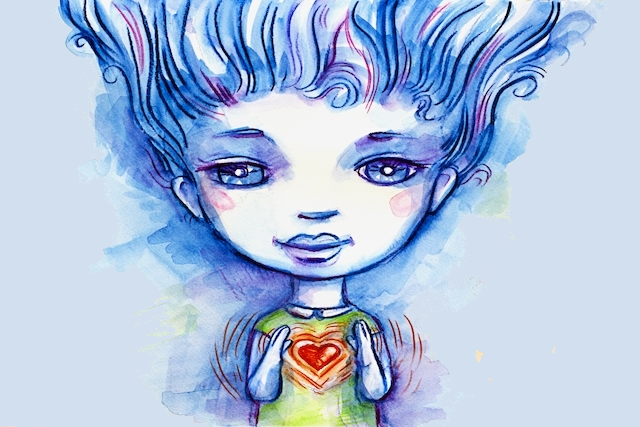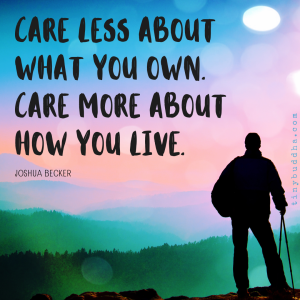
“The pressure to be grateful kept me away from the more painful and real feelings of grief, anger, and abandonment. Growing up, gratitude was one more brick on the pile that kept all of the secrets of abuse in place. It was just one more thing that made me feel like being who I am, as I am, isn’t enough.” ~Vicki Peterson
The pathway to gratitude for a person with developmental trauma is not always straightforward.
You try your best and even purchased a journal specifically to try the ritual for yourself, but all you can think of to be thankful for is the usual stock stuff, like a roof over your head and your warm bed.
Sometimes you think, “I should be grateful for this or that,” but your heart remains silent.
If so, you’re not alone.
Gratitude practice has become a part of self-development and therapy, but doling out “be grateful for what you have” advice to a traumatized person can make her feel worse.
It happened to me, too. I tried, but the feeling wasn’t there, and the everlasting “something must be wrong with me” was banging in my head.
Then one day I was walking along the fjord, watching the waves softly touching sandy shores. Consciously, I thought about how fortunate I was to live in this picturesque place, but wondered, “Why can’t I feel it?”
“Your childhood holds the key.” The thought suddenly touched my mind and began to unroll like a serpentine ribbon thrown into the air.
And it all started to make sense.
Meet the Ungrateful Pig
I grew up with an unhappy mother who struggled with a legacy of emotional abuse and personality disorder that had been running in her family for generations. A fragile feeling of self-worth, chronic anxiety, and depression kept her in the prison of a perpetual drama.
She couldn’t cope in any other way than projecting her pain onto us—my dad and me. The people who loved her and whom she loved, too, in her own destructive way.
Mom tried her best, and she never failed to satisfy our physical needs. She even sewed me bright dresses, when my friends wore the boring, shapeless outfits of our communist past. But the price was high: total obedience and gratitude, even for abuse.
Be grateful that I gave you life. I nearly died!
Do you know how many children don’t have mothers, you ungrateful pig?!
Say thank you for not sending you to an orphanage.
You have everything you need. Why can’t you just shut up and be grateful?
Was I grateful?
Yes, I was, as my instincts advised. Mom not only minimized or dismissed my feelings and needs, she also wanted me to like the pain attached to the gratitude. Any gratitude I felt was therefore melted together with shame, anger, and hopelessness. That forced gratitude was abuse itself.
And saying thank you, I felt violated to the core.
I grew up and accepted my mother for who she was. I forgave her in time, but gratitude remained a stumbling block on my healing path. So, I shoved the journal to the back of my bookshelf, somewhere between Nietzsche and the South Beach Diet.
How could I appreciate the word “gratitude” when even the meaning of it was lost to me? How could I trust myself, my experiences, and my feelings?
Now I understood, but I still didn’t feel. Until last week.
Let me explain.
The Path to Gratitude Lies Through Curly Hair
A week ago, I was chatting with my hairdresser while she handled my curly hair. It’s the type you’d think you set in perfect shape, and a moment later it turns into something else, like a pool of ink shifting at the slightest movement of paper.
We talked about families and politics, then straight versus curly hair types, and she complimented mine. Unexpectedly, I felt grateful for the unruly hair I have: it fits my face so well.
But I always knew that. What made the difference this time?
Silke, my hairdresser, is one of the loveliest people I know. She’s genuine, kind, and funny, and I enjoy spending time with her. When she complimented my hair, I felt good not just about this physical part of me but about myself, too. At that moment, something shifted, and I finally moved from “I think” to “I feel.”
I still have to put in some work to exercise it, but I finally know how gratitude feels.
Nothing’s Wrong with You
As a kid, you had no place to go and no strength to fight the adults in your life, so you hid your feelings to protect yourself. To feel again, you need to accept and own your unique experiences, both good and bad.
You have to process those forbidden, muted emotions you still carry inside—sadness, anger, and shame—to make space for joy, compassion, and gratitude. To reconnect with your wise self and modify your perception of life.
When you’re able to hold the good and the bad at the same time and see the other side of the events, you may feel gratitude for the strength of your resilience that helped you survive. Warmth toward someone who gave you love when your parent couldn’t. Be thankful for the compassionate and sensitive side of you that is attuned to others’ needs.
But you don’t have to be grateful for pain.
Gratitude Is Good for You
Gratitude brings positivity, improves well-being, and gives your health a boost. Do you want that? Great, let’s go!
Here’s what I want you to do. Pay attention to the things in your everyday life that make you feel good, and tune into your senses. Notice those subtle, but clear “here and now” sensations in your body—they are the vital parts of each experience you want to know.
Notice how gentle the warm sun feels on your skin and how soothing the birds’ singing is.
Feel the warmth in your chest when you look into the eyes of a child, and the bobbles in your belly when your lover holds you in his hands.
Regard how the smell of a freshly baked bread takes you back to your happiest memories, and a subtle caramel taste of your favorite tea.
Note a smile on your face in response to a friendly smile of a stranger passing by, or how good it feels when the evening breeze caresses your hair.
Be aware of the sensation of sand stuck between your toes, and the rhythm of your breathing.
Then, before bedtime, you can recapture these “here and now” sensations of joy, no matter how brief they were. Learn to pay attention to your surroundings and your body.
For example, tonight I’ll go to bed feeling relaxed and joyful after spending a day with an old friend. We had a great time walking in the park, talking about things that matter to both of us, and revisiting shared memories. I’ll remember being listened to and understood and recall the sense of warmth in my chest. I’ll end my day on that authentic note of gratitude.
There are many tiny things you can notice every day if you pay attention and exercise your awareness—they are the source of joy and gratitude. Zoom in to them!
Learning to be aware of the moment and related bodily sensations take time and practice, but it’s worth it. It helps to recover the authentic feeling of gratitude and minimize the numbness many people with a developmental trauma are dealing with.
You can do it!
About Irina Bengtson
Irina is a daughter of a narcissistic mother, clinical psychologist and a founder of www.LoveGrowBeHappy.com. She combines her professional knowledge with a healing experience to help other daughters of narcissistic, hurtful mothers break free from their dysfunctional relationships. She’s a creator of online courses How to Set Boundaries and Protect Yourself from Hurt, The Ultimate Guide to De-stressing and Enjoying Life Now, and How to Cope with a Hurtful Mother and Reclaim Your Life.













 Though I run this site, it is not mine. It's ours. It's not about me. It's about us. Your stories and your wisdom are just as meaningful as mine.
Though I run this site, it is not mine. It's ours. It's not about me. It's about us. Your stories and your wisdom are just as meaningful as mine.